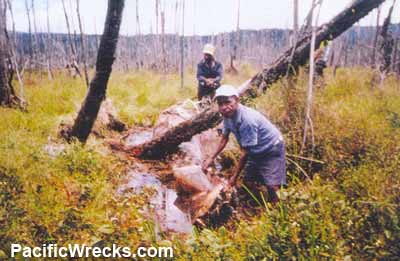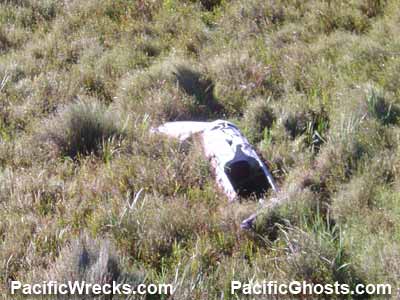|
|
|
|
| Missing In Action (MIA) | Prisoners Of War (POW) | Unexploded Ordnance (UXO) |
| Chronology | Locations | Aircraft | Ships | Submit Info | How You Can Help | Donate |
|
| IJN Tainan Kōkūtai 1st Chutai 2nd Shotai  RAAF late May 1942  Lawrence Kiilemu 1990s  Justin Taylan Aug 27, 2005 |
Pilot PO2c Tsutomou Ito (POW, survived) Crashed May 17, 1942 Aircraft History Built by Nakajima completed February 27, 1942. At the factory, painted with gray surfaces and a black engine cowling. Delivered to the Imperial Japanese Navy (IJN) as Type 0 Carrier Fighter / A6M2 Model 21 Zero manufacture number 656. Wartime History Assigned to the Tainan Kōkūtai (Tainan Air Group). Tail code V-1?? (last two digits unknown). Mission History On May 17, 1942 took off from Lae Airfield near Lae piloted by P. O. 2nd Class Tsutomou Ito on a fighter sweep and strafing mission against Port Moresby. Ito part of the 1st Chutai, 2nd Shotai flying as the wingman for A6M2 Zero pilot Yamaguchi. Over the target, Yamaguchi and Ito dove to low level to strafe 12 Mile Drome. During the strafing run, this Zero sustained engine damage from .50 caliber machine guns on the ground. Also damaged was A6M2 Zero pilot Yamaguchi that rejoined formation but lagged behind then crashed in the Owen Stanley Range. Damaged, Ito did not rejoin the formation and attempted to fly alone northward to Lae. Alone over the Owen Stanley Range, his engine stopped. As he force landed, trees tore off the outer wings and twisted the tail. Ito survived the landing dazed but otherwise unhurt. Fate of the Pilot Afterwards, he began walking and at night slept in trees. He found local people and with their assistance was escorted from village to village. On May 23, 1942 Australian New Guinea Administrative Unit (ANGAU) Patrol Officer (Kiap) Eric-Owen Turner at Ononge Mission was alerted to the presence of a Japanese pilot in the area and went in pursuit of him. On June 2, 1942 Turner confronted Ito, who drew his pistol but was restrained by villagers. Once disarmed, he offered no further resistance. Accompanied by Turner and a group of police and boys, Ito was walked out of the Owen Stanley Range via Ioma to Awala then westward over the Kokoda Trail and then to Port Moresby. Ironically, he was the only Japanese person to walk the entire Kokoda Trail. Prisoner of War When initially interrogated, he falsely claimed his name was "Tetsuo Yamakawa" and that his hometown was Okayama. During late June 1942, he was flown to Townsville. As a Prisoner Of War (POW), he was placed in the custody of Royal Australian Air Force (RAAF) Intelligence and assigned prisoner number PWJA.110009. Next, he was transported to Redholme Manson in South Yarra, Victoria for further interrogation. At Redholme Manson, he suffered a bout of malaria for four days. When interrogated further, he claimed he was the co-pilot of a bomber from the "Araki Butai" and the sole survivor of his crew, in hopes the Allies would not look for his Zero. Under more detailed interrogation, his cover story did not hold up. In one telling he claimed his bomber was damaged by anti-aircraft fire. In another telling he claimed it was damaged by fighters. Also, he claimed to have flown bombing missions on May 15, 1942 and May 22, 1942 over Port Moresby but no bombers were observed on either date. In later interrogations he admitted: "On May 17, 1942 I was strafing Moresby air base [12-Mile Drome] following Lt. Yamaguchi. AA fire perforated the engine. I decided to return to Lae by direct route. While flying solely, engine stopped and crash landed in the jungle before crossing the ridge." Afterwards, he was transferred to Hay Camp, NSW on September 14 and quartered with civil internees and volunteered to work at road maintenance to earn extra money to buy things at the canteen. On January 9, 1943, sent to Cowra POW Camp. He was again hospitalized February 17, 1943 until March 11, 1943 then returned to the camp. On August 5, 1944 at 2:00am Ito participated in the "Cowra Breakout" and spent the night pinned down by machine gun fire in a storm drainage ditch. The next morning, he ran towards a sentry post, and ignored orders to halt in an apparent attempt to commit suicide. He was shot twice and immobilized with compound fractures to both shoulders and taken to Murchison Camp. Hospitalized from August 22, 1944 until March 7, 1945, then returned to Murchison Camp. On March 12, 1945 to Liverpool. On March 1, 1946 taken to Sydney and embarked aboard Daikai Maru departing March 2, 1946 and was repatriated to Japan. Postwar, he lived under an assumed name "Isshiki". He never participated in Zero Pilot Reunion events. Saburo Sakai also confirmed Ito was reluctant to apply for medical benefits from the Japanese Government as he was ashamed of his captivity. Eventually he applied by Sakai's advice, but he claimed in an affidavit that he crashed and survived the war with natives until liberated. Naoki Kodachi, V-P of Zero Fighter Association: "We do not know if Mr Tsutomu Isshiki (former PO2/c Tsutomu Ito) is alive or not and the Association will not make contact with him even if he is found alive because Ito was said to be unwilling to meet any of surviving comrades and was not a member of the Association. He was ashamed of his being a POW." Wreckage After the crash landing, this Zero was found in a swamp near Kosipe. Later, the aircraft was visited by a team from U.S. Army that noted the manufacture number as 645 and recovered the main dataplate. In the 1950s, a missionary based in the area removed the plane's electric generator and brought it to the mission where it was modified with a fly wheel to generate power. Lawrence Kilemu adds: "You will see the tree is right across the plane but the tree grew later and natural humidity and surrounding air caused the tree to bend the airplane." Justin Taylan adds: "Yoji Sakaida, Daniel Leahy and myself inspected this wreck on August 27, 2005." References Production figures of the Mitsubishi/Nakajima A6M Zero by Jim Long Pacific Wrecks - Port Moresby Air Raid May 17, 1942 Fighter Sweep Over Port Moresby Winged Samurai (1985) by Henry Sakaida "Zero in the Tree Tops" by Robert Piper (unpublished) Australian Post "Where Japs got the third degree" by David Sissons, July 17, 1986, page 4 "SWPA Technical References to Inspected Enemy Airplanes" ATIU, September 27, 1943, page 2 Japanese Aircraft - Plates and Markings No. 87 Jim Long adds: "A6M No. 645 is listed in two documents as a Nakajima built A6M2. The documents are Makers' Plates & Markings Report #68, "Life of Japanese Combat Planes," issued by the Military Intelligence Division, War Dept., 20 March 1945, and "Preliminary Report on Japanese Fighter Plane Production (based solely on name-plate analysis)," compiled by the Joint Intelligence Subcommittee, Working Committee on Japanese Aircraft, 1 June 1943. Neither of these documents does anything more than list the aircraft by serial number 645 and manufacturer and give its date of assembly as 27 February 1942. In addition, MP&M No. 68 identifies the date of crash as Mid May 1942 in Kosipi [sic] swamp." Contribute Information Are you a relative or associated with any person mentioned? Do you have photos or additional information to add? Last Updated May 11, 2025 |
Zero Dataplate |
| Discussion Forum | Daily Updates | Reviews | Museums | Interviews & Oral Histories |
|